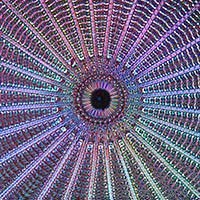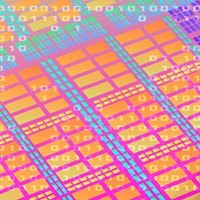QIS and Quantum Sensing in Biology Interest Group
Join us for our monthly seminar series on Quantum Technologies (i.e. Quantum Sensing, Quantum Biology and Quantum Computing). Please see Upcoming Events below.
For updates, please join the Quantum SIG mailing list: QuantumSIG@LIST.NIH.GOV(external link). Click “Subscribe or Unsubscribe” on the right
About the QIS and Quantum Sensing in Biology Interest Group
Studies in Quantum Information Sciences (QIS) and quantum sensing in biology (QSB) are rapidly advancing for biomedical applications. Many cellular and sub-cellular phenomena such as photosynthesis, neuro-transmission and cognition, enzyme tunneling, mitochondrial electron transfer have been shown to involve quantum physicochemical components. With advances in AI/ML and quantum computer designs, applications in biomedical sciences such as sensing weak electromagnetic signals in neurons and tissues, in-vivo imaging, biomolecular modelling, data encryption, privacy and storage have become fruitful areas of exploration. These developments will impact the understanding of complex disease biology and enable new modalities for drug and biomarker discovery in the next decade.
The QIS and Quantum Sensing in Biology Interest Group was initiated by NCATS within the NIH-wide QIS Working Group. Since quantum science is evolving at the cutting-edge of both computer science, materials technology and biology, activities of this SIG will be of wider interest to data/information scientists, bioengineers, chemists, biologists, physicists, and clinicians at NIH.
Please visit NIH Quantum Biomedical Innovations and Technologies (Qu-BIT) Program website at https://ncats.nih.gov/research/research-activities/quantum.
Partners
- Join us and our international partners for remote "Big Quantum Biology Meetings" organized by Leverhulme Quantum Biology Doctoral College Training Centre (QB-DTC) and the Quantum Biology Tech (QuBiT) Lab at UCLA. Seminars are held via Zoom every Thursday from 3pm - 4pm UK time (7am PT / 10am ET / 11am BRT / 4pm SAST, CEST / 11pm JST). Sign up for reminders at https://groups.google.com/g/bigquantumbiologymeetings.
- The Guy Foundation hosts online lectures on the role of quantum mechanics and thermodynamics in biology with the ultimate goal that this understanding can be used to advance healthcare. Attendance at The Guy Foundation live seminars is by invitation. If you are keen to attend, please email Betony Adams to register your interest: b.adams@theguyfoundation.org. The sessions are also recorded and available to watch on their website at https://www.theguyfoundation.org/our-conferences-and-meetings or on their YouTube channel at https://youtube.com/@theguyfoundation. For more information about the Foundation, visit https://www.theguyfoundation.org.
Goals
A major goal is to identify biomedical problems that may be amenable for quantum information/sensing applications for the measurement of highly sensitive and specific biological and cellular signals in normal and diseased states. In addition, we hope to illuminate use cases that can be optimized and developed further for wider adoption by the community through enabling development of easily accessible bench-top instrument and portable devices and wearables. These goals will be accomplished through invited seminars, workshops from national and international experts in QIS/QSB, identifying opportunities for learning, training and workforce development for fellows and trainees in collaboration with academia, industry, and government agencies.
Principal Contacts
- Geetha Senthil, PhD, Deputy Director, Office of Special Initiatives, NCATS, geetha.senthil2@nih.gov
- Paige Derr, PhD, Scientist, Division of Preclinical Innovation, NCATS, paige.derr@nih.gov
To join the Quantum SIG mailing list, please visit the Listserv home page QuantumSIG@LIST.NIH.GOV click the “Subscribe or Unsubscribe” link in the right sidebar.
Upcoming Events
December 8, 2025 12:00-1:00 pm EST
Join meeting
Amir Ghods, Vice President of Photonics at Mesa Quantum Systems
https://mesaquantum.com/
Quantum-Optimized VCSELs for Atomic Clocks and Portable Biomedical Sensors
Abstract: Quantum-optimized VCSELs (Q-VCSELs) are semiconductor lasers designed to deliver narrow linewidths, low phase noise, polarization stability, and robust thermal performance—features critical for both atomic and biomedical sensing. At 795 nm, the same platform supports coherent population trapping in rubidium-87 atomic clocks as well as optically pumped magnetometers for brain and cardiac monitoring. Recent results demonstrate linewidth and noise suppression, thermal stability, and high-contrast CPT performance, translating directly into improved frequency stability in chip-scale clocks and enhanced sensitivity in magnetometry. With wafer-scale manufacturability and low electrical power requirements, Q-VCSELs provide a scalable and cost-effective solution for precision timing, navigation, and portable biomedical diagnostics, highlighting a common photonics foundation for diverse quantum and health-related applications.
Bio: Amir Ghods is Vice President of Photonics at Mesa Quantum Systems, where he leads the development of advanced semiconductor lasers for quantum sensing applications. His work focuses on high-efficiency, narrow-linewidth VCSELs for atomic clocks, magnetometers, and biomedical sensors. Prior to Mesa Quantum, he was Senior Staff Scientist at ams OSRAM, directing VCSEL epitaxial design for 3D sensing. He received his Ph.D. in Electrical Engineering from Missouri University of Science and Technology, has authored over 45 technical papers, and filed 14 patents in optoelectronics.
Past Events
September 22, 2025
"Bioelectricity: a bridge between physics and cognition, by way of biology"
Michael Levin, Tufts University
August 25, 2025
"Mechanism of giant magnetic field effect in a fluorescent protein"
Adam Cohen, Harvard University
July 28, 2025
"Superradiant Life: On Slime Molds, Sentience, and the Stars"
Philip Kurian, Quantum Biology Laboratory
June 23, 2025
"Molecular Platforms for Quantum Sensing"
Ezekiel Johnston-Halperin, The Ohio State University
June 2, 2025
"Uncovering Radical Pair Mechanisms: Magnetic Field-Dependent Isotope Effects in Tubulin Assembly"
Travis Craddock, University of Waterloo
January 13, 2025
"Decoding and Programming Cellular States Using Biophysical Signals"
Nirosha Murugan, Wilfred Laurier University
December 16, 2024
"Expanding the Horizon: Enabling Hybrid Quantum Transfer Learning for Long-Tailed Chest X-Ray Classification”
Skylar Chan, Imaging Biomarkers and Computer-Aided Diagnosis Laboratory, NIH Clinical Center
October 28, 2024
“Next-generation fluorescent nanodiamond for biological quantum sensing”
Marco Torelli, Ph.D. , Adamas Nanotechnologies, Inc., Raleigh, NC.
September 30, 2024
"Developing an OPM Magnetocorticography System"
Allison Nugent, NIMH Magnetoencephalography (MEG) Core Facility
August 26, 2024
"Using Quantum-Limited Sensors to Listen to Biological Systems"
Matthew Eichenfield, University of Arizona
July 29, 2024
"Case studies on physical complexity in quantum states: from quantum phase transitions to quantum cellular automata – with a segue on quantum bio-sensing and engineering"
Lincoln Carr, Colorado School of Mines
June 24, 2024
"Quantum Biology in Chromoproteins and its Implications for Quantum Sensing”
Youngchan Kim, University of Surrey
May 20, 2024
"NV-Diamond Magnetic Sensing and Imaging for Biomedical Applications"
Connor Hart, CTO, Quantum Catalyzer, LLC and Stephen DeVience, Founder, Scalar Magnetics, LLC and Principal Quantum Scientist, Quantum Catalyzer, LLC
April 29, 2024
"Controlling Cell Behaviors and Cell Fate with Engineered Magnetosensitive Proteins"
Yun Chen, Associate Professor, Department of Mechanical Engineering, Johns Hopkins University
March 25, 2024
"In the world and at QuantumBasel: the state of quantum computing applications in health and medicine"
Dr. Frederik F. Flöther, QuantumBasel
February 26, 2024
"Exploring Quantum Sensors of Living Systems: From NMR to NV Centers and Beyond"
Albert Siryaporn and Luis Jauregui, University of California Irvine
January 22, 2024
"What applications are the Swedes working on in the Swedish Quantum Life Science Centre?"
Ebba Carbonnier, Swedish Quantum Life Science Centre, Karolinska Institutet; Göran Johansson, Wallenberg Center for Quantum Technology (WACQT), and Daniel Lundqvist, Karolinska Institutet
December 11, 2023
"Investigating Stem Cells as Quantum Sensors"
Wendy Beane, Associate Professor of Biological Sciences, Western Michigan University
October 30, 2023
"The ‘Quantum Underground’ – How and Where Life Defeats Decoherence"
Stuart Hameroff M.D., Anesthesiology, Psychology, Center for Consciousness Studies, The University of Arizona
September 25, 2023
"Quantum Biology: how nature harnesses quantum processes to function optimally, and how might we control such quantum processes to therapeutic and tech advantage"
Clarice Aiello, Quantum Biology Tech Lab, UCLA
August 28, 2023
"Molecular mechanisms of Li action in neurodegeneration, effect of Li isotopes and quantum neuroscience"
Zoya Leonenko, Department of Physics & Astronomy, Department of Biology, Waterloo Institute for Nanotechnology
August 21, 2023
"IBM Quantum"
Joseph S. Broz, Ph.D., IBM Vice President, Quantum Strategy and Growth, Thomas J. Watson Research Center; Travis L. Scholten, Technical Lead for the Public Sector at IBM Quantum; Marilyn Wagner, Head of Quantum Health Care & Life Sciences, Aerospace & Defense and the US Government for IBM
July 31, 2023
"Beyond Molecules: Harnessing Biophysics and Quantum Mechanics for the Development of Novel Diagnostics and Therapies"
Nirosha Murugan, Ph.D., Assistant Professor, Department of Health Sciences, Wilfred Laurier University
June 26, 2023
"Using Fluorescent Proteins to Explore Quantum Behavior in Chromoproteins: Molecular Exciton Entanglement"
Steven Vogel, Ph.D., Laboratory of Biophotonics and Quantum Biology, National Institute on Alcohol Abuse and Alcoholism (NIAAA)
April 24, 2023
"Diamond Voltage Microscopy for Neuronal Electrophysiology"
David A. Simpson, School of Physics, University of Melbourne
March 27, 2023
"NIH QIS Quantum Sensing Webinar: Nanodiamond Is Forever: Fluorescent Nanodiamonds for in Vitro and in Vivo Biological Imaging"
Keir C. Neuman, Ph.D., NHLBI
February 27, 2023
"Photon Correlation Measurements for Quantitative Biology"
Sergey Polyakov, Ph.D., NIST
January 23, 2023
"Beyond the Science: An Industry Perspective on Where Quantum Will Impact Biomedicine"
Celia Merzbacher, Ph.D., SRI International
January 5, 2023
"Near-term Applications of Quantum Sensing Technologies in Biomedical Sciences"
NIH Virtual Full-Day Workshop (6.5 hours)
YouTube Link: https://www.youtube.com/watch?v=5Z74MiJ4j8o
December 7, 2022
"A Quantum Revolution in Drug Discovery"
Shahar Keinan, Ph.D., Polaris QB
November 28, 2022
"Rapid and simple ultra-sensitive diagnostics with quantum magnetic sensing"
Colin Connolly, Ph.D., Quantum Diamond Technology, Inc.
Reference Links
- Emani PS et al., “Quantum computing at the Frontiers of biological sciences,” Nat.Methods, https://www.nature.com/articles/s41592-020-01004-3
- “Quantum Science Concepts in Enhancing Sensing, and Imaging Technologies: Applications for Biology A Workshop,” March 8-10, 2021, National Academy of Sciences, Washington, DC, https://www.nationalacademies.org/event/03-08-2021/quantum-science-concepts-in-enhancing-sensing-and-imaging-technologies-applications-for-biology-a-workshop
- National Academies quantum sensing workshop publication and summary, https://www.nationalacademies.org/our-work/quantum-science-concepts-in-enhancing-sensing-and-imaging-technologies-applications-for-biology-a-workshop
- Office of Science & Technology Policy, The White House: Quantum Sensing Technology White paper, https://www.quantum.gov/wp-content/uploads/2022/03/BringingQuantumSensorstoFruition.pdf
- Office of Science & Technology Policy, The White House: Quantum Information Science and Technology Workforce Development, https://www.quantum.gov/wp-content/uploads/2022/02/QIST-Natl-Workforce-Plan.pdf
Scientific Focus Areas

Biomedical Engineering and Biophysics
View SIGs in Biomedical Engineering and Biophysics
Learn more about Biomedical Engineering and Biophysics in the IRP

Computational Biology
This page was last updated on Friday, November 14, 2025